The year 1918 is drawing to a close and Big Ben in London is about to
start striking the midnight hour. Six hundred miles to the north, HMY Iolaire is
ploughing her way north through the Minch, passing between Raasay,
Rona and the Scottish mainland. The weather, which had been reasonable
upon departure from Kyle, is turning increasingly windy. A heavy swell
is beginning to rise in response to the strong southerly wind. The
lighthouses, which serve as reference points for mariners in the Minch,
blink their messages to Iolaire. Milaid, on the rocky cliffs
near Kebock Head; Rona; Tiumpan Head on the eastern extremity of the
Point Peninsula; and Arnish, near the entrance to Stornoway Harbour.
In dozens of houses in Lewis, glasses are charged to the New Year. The last year of war is ending. Dry
clothes are draped over beds, a stew is heating over the fire. In the
blackhouses in Ness, and the town houses of Stornoway. A kettle is at
the ready on the stove. A plate, cutlery and cups on the table. From
Eoropie to Brenish, from Lemreway to North Tolsta, and between Manor
Park and Newton, the same scene is repeated over and over. Only two
hours to go, the boat won't make Hogmanay. But it does not really
matter, the boys will be home soon.
The clock strikes midnight. It is 1919.
To be continued
Thursday, 31 December 2015
97 years ago tonight
It is Hogmanay 1918, and the war has been over for seven weeks.
Survivors from the Western Front and the war at sea are flocking home.
As are hundreds of sailors from the Highlands and Islands of Scotland.
Three trains pull into the harbourside station at Kyle of Lochalsh, and
hundreds pour onto the platform and adjoining quayside to join a ferry
home. The Skye men can take the short hop to Kyleakin, or join the
steamer north to Portree. The sailors and soldiers from the Outer
Hebrides have a longer journey ahead of them.
The mailsteamer for Stornoway, the Sheila is alongside at Kyle, but it very rapidly becomes clear that she has nowhere near enough space to accommodate the hundreds that want to go home to Lewis and Harris. So, a cable is sent to the naval base at Stornoway, and Rear Admiral Boyle sends HMY Iolaire to Kyle to relieve the congestion. Iolaire, the former private steamyacht Amalthea, arrives in the early evening, bumping into the pier as she docks.
A disorganised scramble occurs, where the throng of men divides between the Sheila and the Iolaire. No record is kept as to who goes on board which vessel. Some start off by boarding the Iolaire, then switch to the Sheila. Others do the reverse swap. Finally, at half past seven, Iolaire casts off and heads north. The Sheila follows suit in short order.
The mailsteamer for Stornoway, the Sheila is alongside at Kyle, but it very rapidly becomes clear that she has nowhere near enough space to accommodate the hundreds that want to go home to Lewis and Harris. So, a cable is sent to the naval base at Stornoway, and Rear Admiral Boyle sends HMY Iolaire to Kyle to relieve the congestion. Iolaire, the former private steamyacht Amalthea, arrives in the early evening, bumping into the pier as she docks.
A disorganised scramble occurs, where the throng of men divides between the Sheila and the Iolaire. No record is kept as to who goes on board which vessel. Some start off by boarding the Iolaire, then switch to the Sheila. Others do the reverse swap. Finally, at half past seven, Iolaire casts off and heads north. The Sheila follows suit in short order.
Labels:
iolaire
Saturday, 4 April 2015
Gallipoli
This is an amended repost of an original entry, which I made on 16 October 2013.
Gallipoli, known in Turkish as Çanakkale, which lies at the entrance to the Dardanelles Strait, west of Istanbul. In 1915, this was the site of a nine-month battle between Allied and Turkish forces. The Allies, including a large contingent of Australian and New Zealand (ANZAC) forces, were trying to capture the fortresses and thereby the Dardanelles Strait, opening up a way to Constantinople (as Istanbul was known then) and a way to take Turkey out of the First World War. Poor intelligence is quoted as one of the reasons for the catastrophic failure of the Allies to achieve their aims. Both sides lost a quarter of a million lives. The names Gallipoli and Dardanelles now live on with a shadow over them. Among the Allied casualties were (at least) twelve men from the Isle of Lewis. This post is a salute to the Fallen of Gallipoli, particularly to the twelve men from Lewis, whom I list below.
Driver NORMAN CAMPBELL
Son of Donald and Jessie Campbell
Last address in Lewis: 12 Aird, Point
Service unit: Royal Garrison Artillery, 4th Highland Battery
Service number: 4288
Date of death: 9 August 1915 at the age of 20
Died of wounds sustained at Suvla Bay
Memorial: Helles Memorial, Panel 23 or 325
Local memorial: Point (Garrabost); Nicolson Institute WW1, left panel
Gunner MURDO MACAULAY
Last address in Lewis: 2 Keith Street, Stornoway
Service unit: Royal Garrison Artillery, 4th Highland Battery
Service number: 4401
Date of death: 15 July 1915 at the age of 22
Died in Malta, of wounds incurred on 11 June 1915
Interred: Pieta Military Cemetery grave B. II. 3
Local memorial: Lewis War Memorial; Nicolson Institute WW1, left panel
Seaman JOHN MACDONALD
Son of Angus and Annie McDonald
Last address in Lewis: 2 Swordale
Service unit: Royal Naval Reserve, HMS Hythe
Service number: 7320/A
Date of death: 28 October 1915 at the age of 19
Ship sank after a collision at the Dardanelles
Memorial: Chatham Naval Memorial, panel 14
Local memorial: Point (Garrabost)
Gunner JOHN MACDONALD
Husband of Catherine, father of Ian, Kenneth and John
Last address in Lewis: 4 Plantation Road, Stornoway
Service unit: Royal Garrison Artillery, 4th Highland Battery
Service number: 4403
Date of death: 15 May 1915 at the age of 39
Died of wounds on board hospital ship
Memorial: Helles Memorial, panel 23 or 325
Local memorial: Lewis War Memorial; Nicolson Institute WW1, left panel
Seaman MALCOLM MACKAY
Last address in Lewis: 3 Achmore
Service unit: Royal Naval Reserve, HMS Triumph
Service number: 4333/B
Date of death: 25 May 1915 at the age of 46
Ship sunk by U-21 at the Dardanelles
Memorial: Chatham Naval Memorial, panel 14
Local memorial: Crossbost
Bombardier ALEXANDER ANGUS MACKENZIE
Son of John and Christy Mackenzie
Last address in Lewis: 4 Crossbost
Service unit: Ross Mountain Battery
Service number: 4319
Date of death: 2 May 1915 at the age of 22
Killed in action in Dardanelles
Memorial: Helles Memorial, panel 23 or 325
Local memorial: North Lochs, Crossbost
Stoker 1st Class HUGH MACKENZIE
Last address in Lewis: 46 Laxdale
Service unit: Royal Navy, HMS Triumph
Service number: 282664
Date of death: 26 May 1915 at the age of 47
Ship sunk by U-21 at the Dardanelles
Memorial: Portsmouth Naval Memorial, panel 8
Local memorial: Lewis War Memorial
Gunner NORMAN MACLEAN
Son of Donald Maclean
Last address in Lewis: 5 Vatisker
Service unit: 4th Highland Mountain Bde, Royal Garrison Artillery
Service number: 4335
Date of death: 18 May 1915 at the age of 22
Died in Egypt
Interred: Alexandria (Chatby) Military and War Memorial Cemetery grave L. 194
Local memorial: Back; Nicolson Institute WW1, middle panel
Gunner JOHN MACLEOD
Son of Murdo and Mary Macleod
Last address in Lewis: 18 Aignish
Service unit: Royal Garrison Artillery, 4th Highland Battery
Service number: 4316
Date of death: 9 August 1915 at the age of 22
Died at sea of wounds sustained at Gallipoli
Memorial: Helles Memorial, panel 23 or 325
Local memorial: Lewis War Memorial
Seaman KENNETH NICOLSON
Son of Angus and Isabella Nicolson
Last address in Lewis: 24 Lemreway
Service unit: Royal Naval Reserve, HMS Goliath
Service number:
Date of death: 13 May 1915 at the age of 19
Ship sunk by Turkish warship off Cape Helles
Local memorial: Pairc, Kershader
Seaman DONALD SMITH
Son of Donald and Annie Smith; husband of Marion Campbell Smith
Last address in Lewis: 43 North Bragar
Service unit: Royal Naval Reserve, HMS Goliath
Service number: 2350D
Date of death: 13 May 1915 at the age of 40
Ship sunk by Turkish warship off Cape Helles
Memorial: Chatham Naval Memorial, panel 14
Local memorial: West Side, Bragar
Sergeant DONALD STEWART
Son of Elizabeth Stewart, of 32, Argyll Square, Oban.
Last address in Lewis: 85 Cromwell Street, Stornoway
Service unit: Royal Garrison Artillery, Argyll Mountain Bty. 4th (Highland) Mountain Bde.
Service number: 1003
Date of death: 7 November 1915 at the age of 25
Killed in action at Suvla Bay
Interred: Hill 10 Cemetery grave II. C. 15
Local memorial: Lewis War Memorial; Nicolson Institute WW1, right panel
Gallipoli, known in Turkish as Çanakkale, which lies at the entrance to the Dardanelles Strait, west of Istanbul. In 1915, this was the site of a nine-month battle between Allied and Turkish forces. The Allies, including a large contingent of Australian and New Zealand (ANZAC) forces, were trying to capture the fortresses and thereby the Dardanelles Strait, opening up a way to Constantinople (as Istanbul was known then) and a way to take Turkey out of the First World War. Poor intelligence is quoted as one of the reasons for the catastrophic failure of the Allies to achieve their aims. Both sides lost a quarter of a million lives. The names Gallipoli and Dardanelles now live on with a shadow over them. Among the Allied casualties were (at least) twelve men from the Isle of Lewis. This post is a salute to the Fallen of Gallipoli, particularly to the twelve men from Lewis, whom I list below.
Driver NORMAN CAMPBELL
Son of Donald and Jessie Campbell
Last address in Lewis: 12 Aird, Point
Service unit: Royal Garrison Artillery, 4th Highland Battery
Service number: 4288
Date of death: 9 August 1915 at the age of 20
Died of wounds sustained at Suvla Bay
Memorial: Helles Memorial, Panel 23 or 325
Local memorial: Point (Garrabost); Nicolson Institute WW1, left panel
Gunner MURDO MACAULAY
Last address in Lewis: 2 Keith Street, Stornoway
Service unit: Royal Garrison Artillery, 4th Highland Battery
Service number: 4401
Date of death: 15 July 1915 at the age of 22
Died in Malta, of wounds incurred on 11 June 1915
Interred: Pieta Military Cemetery grave B. II. 3
Local memorial: Lewis War Memorial; Nicolson Institute WW1, left panel
Seaman JOHN MACDONALD
Son of Angus and Annie McDonald
Last address in Lewis: 2 Swordale
Service unit: Royal Naval Reserve, HMS Hythe
Service number: 7320/A
Date of death: 28 October 1915 at the age of 19
Ship sank after a collision at the Dardanelles
Memorial: Chatham Naval Memorial, panel 14
Local memorial: Point (Garrabost)
Gunner JOHN MACDONALD
Husband of Catherine, father of Ian, Kenneth and John
Last address in Lewis: 4 Plantation Road, Stornoway
Service unit: Royal Garrison Artillery, 4th Highland Battery
Service number: 4403
Date of death: 15 May 1915 at the age of 39
Died of wounds on board hospital ship
Memorial: Helles Memorial, panel 23 or 325
Local memorial: Lewis War Memorial; Nicolson Institute WW1, left panel
Seaman MALCOLM MACKAY
Last address in Lewis: 3 Achmore
Service unit: Royal Naval Reserve, HMS Triumph
Service number: 4333/B
Date of death: 25 May 1915 at the age of 46
Ship sunk by U-21 at the Dardanelles
Memorial: Chatham Naval Memorial, panel 14
Local memorial: Crossbost
Bombardier ALEXANDER ANGUS MACKENZIE
Son of John and Christy Mackenzie
Last address in Lewis: 4 Crossbost
Service unit: Ross Mountain Battery
Service number: 4319
Date of death: 2 May 1915 at the age of 22
Killed in action in Dardanelles
Memorial: Helles Memorial, panel 23 or 325
Local memorial: North Lochs, Crossbost
Stoker 1st Class HUGH MACKENZIE
Last address in Lewis: 46 Laxdale
Service unit: Royal Navy, HMS Triumph
Service number: 282664
Date of death: 26 May 1915 at the age of 47
Ship sunk by U-21 at the Dardanelles
Memorial: Portsmouth Naval Memorial, panel 8
Local memorial: Lewis War Memorial
Gunner NORMAN MACLEAN
Son of Donald Maclean
Last address in Lewis: 5 Vatisker
Service unit: 4th Highland Mountain Bde, Royal Garrison Artillery
Service number: 4335
Date of death: 18 May 1915 at the age of 22
Died in Egypt
Interred: Alexandria (Chatby) Military and War Memorial Cemetery grave L. 194
Local memorial: Back; Nicolson Institute WW1, middle panel
Gunner JOHN MACLEOD
Son of Murdo and Mary Macleod
Last address in Lewis: 18 Aignish
Service unit: Royal Garrison Artillery, 4th Highland Battery
Service number: 4316
Date of death: 9 August 1915 at the age of 22
Died at sea of wounds sustained at Gallipoli
Memorial: Helles Memorial, panel 23 or 325
Local memorial: Lewis War Memorial
Seaman KENNETH NICOLSON
Son of Angus and Isabella Nicolson
Last address in Lewis: 24 Lemreway
Service unit: Royal Naval Reserve, HMS Goliath
Service number:
Date of death: 13 May 1915 at the age of 19
Ship sunk by Turkish warship off Cape Helles
Local memorial: Pairc, Kershader
Seaman DONALD SMITH
Son of Donald and Annie Smith; husband of Marion Campbell Smith
Last address in Lewis: 43 North Bragar
Service unit: Royal Naval Reserve, HMS Goliath
Service number: 2350D
Date of death: 13 May 1915 at the age of 40
Ship sunk by Turkish warship off Cape Helles
Memorial: Chatham Naval Memorial, panel 14
Local memorial: West Side, Bragar
Sergeant DONALD STEWART
Son of Elizabeth Stewart, of 32, Argyll Square, Oban.
Last address in Lewis: 85 Cromwell Street, Stornoway
Service unit: Royal Garrison Artillery, Argyll Mountain Bty. 4th (Highland) Mountain Bde.
Service number: 1003
Date of death: 7 November 1915 at the age of 25
Killed in action at Suvla Bay
Interred: Hill 10 Cemetery grave II. C. 15
Local memorial: Lewis War Memorial; Nicolson Institute WW1, right panel
Labels:
"ross mountain battery",
gallipoli,
ww1
Saturday, 28 February 2015
The Mathesons
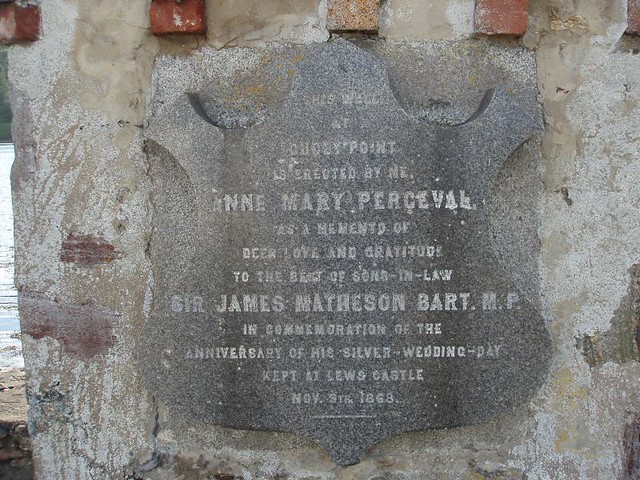
Photographed in September 2006 at Cuddy Point, the plaque dates from 1869, commemorating the silver wedding anniversary of Sir James Matheson and Mary Jane Perceval, held at Lews Castle. Anny Mary Perceval was the mother of Mary Jane, and widow of Michael Henry Perceval. After Sir James Matheson died in 1878, Lady Mary erected a commemorative cupola on the hill above, which was restored in 2005, and pictured in February the following year. The Lewis climate is not kind. Neither is history universally kind on Sir James and Lady Mary. Sir James employed a number of managers who regarded some of the people in the island as so much lumber (read: 1851). Others took advantage of Sir James's absence to abuse their position and wear 32 official hats at the same time, some of which were incompatible with being worn by the same person at the same time (see A Shilling for your Scowl). On the other hand, Sir James can be credited with pushing for some economic developments in Lewis. One of Lady Mary's achievements is mouldering away on Keith Street in Stornoway; the Female Industrial School. Her disputes with crofters in Lochs are well recorded in the Napier Report of 1883.
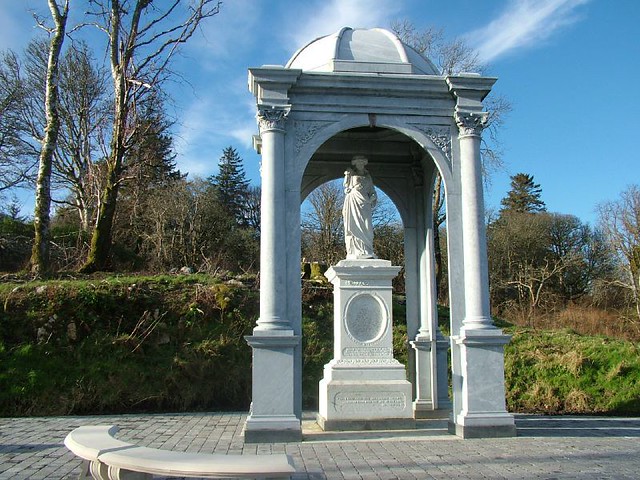
Lady Matheson Memorial
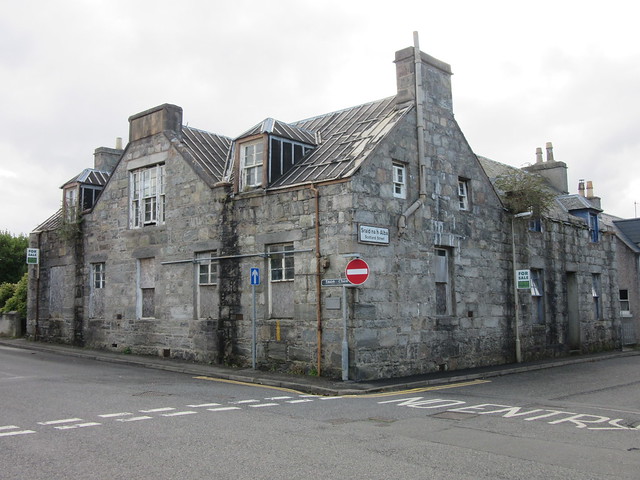
Female Industrial School, Scotland Street / Keith Street, Stornoway
Norge and Titanic
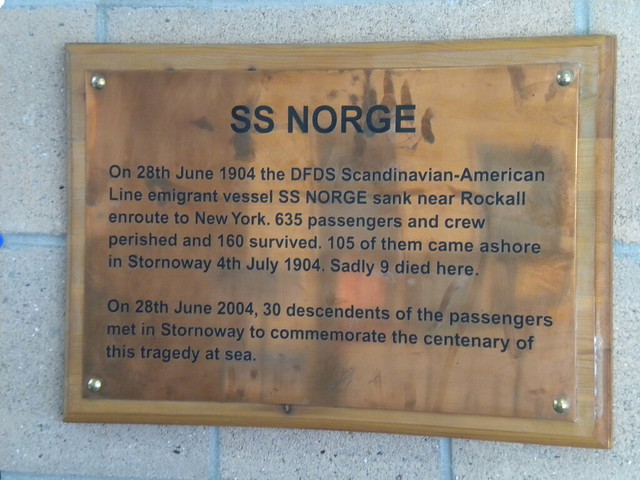
The plaque can be found in the Stornoway ferry terminal, and tells the story of the SS Norge. The gravestone is located in the Old Sandwick Cemetery, and is dedicated to the memory of the nine who were landed in #Stornoway but did not survive. Did you know there is a link with RMS Titanic, which sank on 14 April 1912, with the loss of about 1500 lives? The inquiry that followed the sinking of the Norge concluded that insufficient life-saving apparatus had been on the ship for all on board - 700 drowned for lack of lifeboats etc. It was recommended that all ships should carry sufficient liferafts, lifeboats etc for all on board. But these recommendations were never acted upon at the time. Had they been made compulsory (as they were after the Titanic, in the SOLAS regulations), Titanic's sinking would not have led to the catastrophic loss of life.
We remember the victims of both tragedies.

Bonnie Prince Charlie at Arnish
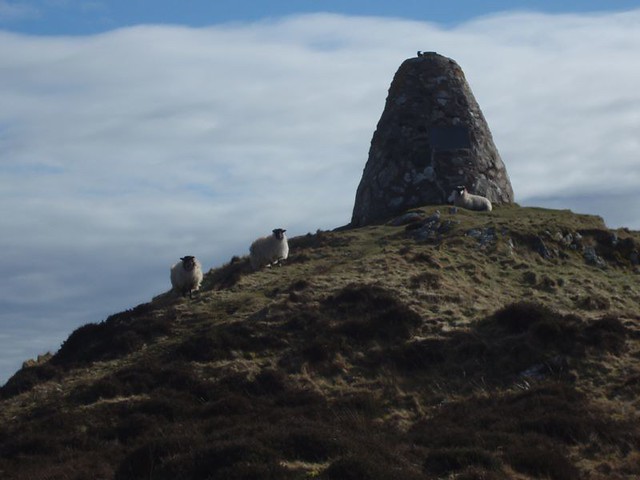

Bonnie Prince Charlie's cairn at Arnish, south of Stornoway.
Kildun, where he stayed the night, is no more. The farmhouse was demolished in 1974 to make way for the Fabrication Yard. Were it to return, it would be floating in thin air - the hill it stood on was bulldozed away.
The below image of the house was taken in the 1950s,

BPC is not a figure in Scottish history I have much time for. He was badly advised, or else he did not take heed of military advice. The consequences of his failure, after being defeated at Culloden in 1746, are well documented. Changes in Scottish society were speeded up, not caused by Culloden. However, Charles Edward gave men like Cumberland the pretext to commit the atrocities that were visited upon the Highlands and Islands in subsequent years. The burghers of Stornoway could not, or would not, give succour to BPC - but neither did they want to betray him. He was allowed to slip away across moor and loch, back to Eilean Iubhair in Loch Shell at Leumrabhagh, and on to his next failed place of shelter.
Goat Island
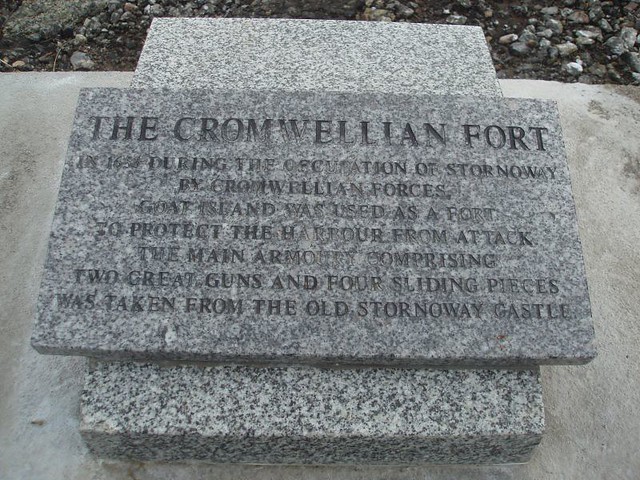
This plaque was placed on Goat Island in 2007. The text, now nearly illegible, reads:
In 1654, during the occupation of Stornoway by Cromwellian forces, Goat Island was used as a fort to protect the harbour from attack. The main armoury comprising two great guns and four sliding pieces was taken from the old Stornoway Castle. RCAHMS suggests that there was a fort or citadel in the Point Street area of Stornoway.
Goat Island is now connected to mainland Lewis by causeway, but until 1946 you needed a boat reach there. This image shows the situation before the construction of the causeway - Goat Island sits in the far right of the image, with the Arnish Lighthouse and beacon to its left.

Land Struggle monuments
There are three memorials to the Landstruggle across Lewis, at Aignish (January 1888), Balallan (November 1887) and Back (1919-1923). They depict three events in the history of the island in which the people fought, sometimes literally (as in the case of Aignish) for their land. The Pairc Raid involved an organised trespass, for which the eight raiders were arrested, tried, convicted and jailed. They returned home as heroes. The Coll raids are depicted as Lord Leverhulme, the then landowner, seeking to divide the crofters among themselves.
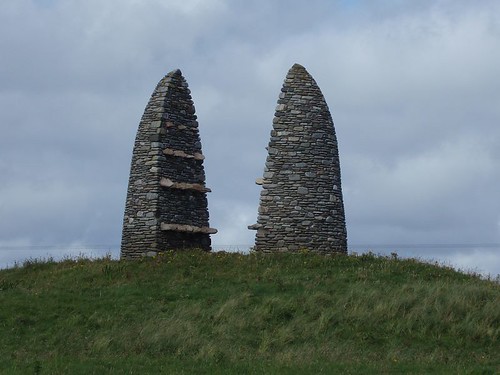
Aignish Farm Raid memorial
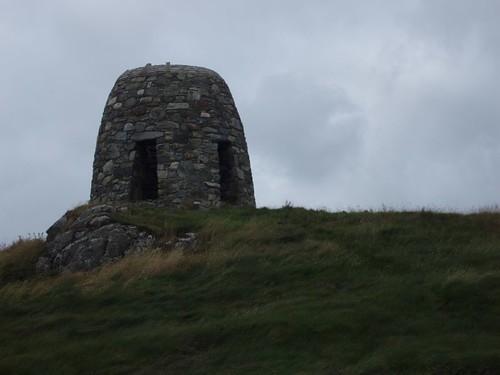
Pairc Raiders memorial, Balallan
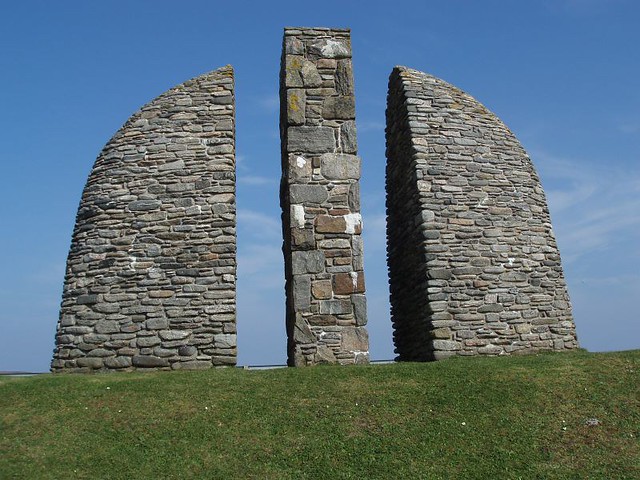
Coll Farm Raiders memorial, Back

Aignish Farm Raid memorial

Pairc Raiders memorial, Balallan

Coll Farm Raiders memorial, Back
Thursday, 1 January 2015
The Iolaire story
This is the full story, as told on this blog in five parts between 6pm on December 31st and 9am on January 1st.
It is Hogmanay 1918, and the war has been over for seven weeks. Survivors from the Western Front and the war at sea are flocking home. As are hundreds of sailors from the Highlands and Islands of Scotland. Three trains pull into the harbourside station at Kyle of Lochalsh, and hundreds pour onto the platform and adjoining quayside to join a ferry home. The Skye men can take the short hop to Kyleakin, or join the steamer north to Portree. The sailors and soldiers from the Outer Hebrides have a longer journey ahead of them.
The mailsteamer for Stornoway, the Sheila is alongside at Kyle, but it very rapidly becomes clear that she has nowhere near enough space to accommodate the hundreds that want to go home to Lewis and Harris. So, a cable is sent to the naval base at Stornoway, and Rear Admiral Boyle sends HMY Iolaire to Kyle to relieve the congestion. Iolaire, the former private steamyacht Amalthea arrives in the early evening, bumping into the pier as she docks.
A disorganised scramble occurs, where the throng of men divides between the Sheila and the Iolaire. No record is kept as to who goes on board which vessel. Some start off by boarding the Iolaire, then switch to the Sheila. Others do the reverse swap. Finally, at half past seven, Iolaire casts off and heads north. The Sheila follows suit in short order.
The year 1918 is drawing to a close and Big Ben in London is about to start striking the midnight hour. Six hundred miles to the north, HMY Iolaire is ploughing her way north through the Minch, passing between Raasay, Rona and the Scottish mainland. The weather, which had been reasonable upon departure from Kyle, is turning increasingly windy. A heavy swell is beginning to rise in response to the strong southerly wind. The lighthouses, which serve as reference points for mariners in the Minch, blink their messages to Iolaire. Milaid, on the rocky cliffs near Kebock Head; Rona; Tiumpan Head on the eastern extremity of the Point Peninsula; and Arnish, near the entrance to Stornoway Harbour.
In dozens of houses in Lewis, glasses are charged to the New Year. The last year of war is ending.
Dry clothes are draped over beds, a stew is heating over the fire. In the blackhouses in Ness, and the town houses of Stornoway. A kettle is at the ready on the stove. A plate, cutlery and cups on the table. From Eoropie to Brenish, from Lemreway to North Tolsta, and between Manor Park and Newton, the same scene is repeated over and over. Only two hours to go, the boat won't make Hogmanay. But it does not really matter, the boys will be home soon.
The clock strikes midnight. It is 1919.
Conditions in the Minch are now poor, and all on board Iolaire are glad that the journey is nearly over. The passengers, most of them familiar with the passage to Stornoway, are snoozing their way, lulled to slumber by the steady if roughish motion of the waves that Iolaire rides. The captain goes down below to rest, his second-in-command takes over on the bridge. A fishing boat is also on its way home to Stornoway, and is running a broadly parallel course to Iolaire.
The passengers can now see the lights of Stornoway ahead, as well as the familiar signal of the Arnish Lighthouse and its secondary beacon. All begin to stir and start to prepare for disembarkation, which is now only about a quarter of or half an hour away. But all is not well. The sound of waves striking shore becomes audible over the noise of wind and swell.
The next noise is a far greater one. Iolaire changes course abruptly, as the crew realise they have overshot the harbour entrance. But it is too late. At 1.55 am, the ship comes to a crashing halt on the rocks of the Beasts of Holm.
Iolaire was mortally damaged by her grounding, and would eventually slip from the rocks and sink into the depths beside the Beasts of Holm. Only her mast would be left showing above the waves.
Flares were let off, which were spotted by the fishing boat and the Sheila, which were running into Stornoway behind Iolaire. Conditions, however, were too severe for any direct help to be offered by any vessel, as they would place themselves into severe danger. One intrepid man managed to bring a hawser ashore, which was to become a literal lifeline for nearly four dozen souls. Others attempted to use the lifeboats, which were almost immediately swamped by the heavy swell, or smashed on the rocks nearby. For Iolaire only grounded about 50 yards from shore. Those who jumped into the sea drowned almost at once, or were smashed onto the rocks, left lifeless. A life-saving apparatus, a breeches' buoy, which had been brought from Stornoway, came way too late to be useful.
Some of those that survived made their way to Stoneyfield Farm, about half a mile from the scene of Iolaire's sinking, and their terrible news was relayed to Stornoway. The flares had been spotted from the town, but had been (mis)taken for celebratory rockets.
The houses waited. The stew over the fire, the teapot on the stove. The clothes on the bed, and the made up table. The families, friends and other islanders waited. Then news filtered through into, and from Stornoway. The Iolaire was lost. Several dozen had been saved. But so many more were not. A night of terrifying uncertainty drew on. Would he be among the saved?
It is early January, and daylight is still many hours away.
It is just after 9 o'clock, and the sun rises over the mountains of mainland Scotland. Its light sweeps west, and shows up a ship's mast protruding from the sea, only a few dozen yards from the shore of Holm Point. The figure of a man can be made out, as he holds on for dear life. As he has done for nigh upon seven hours. Others had been with him, but their strength had given out, and had fallen into the sea below. The man is saved from his precarious position. He had been one of about three hundred on board Iolaire who had left Kyle the evening before, expecting to arrive in Stornoway at 2 am. Instead, two hundred would never return home, and some sixty would never be retrieved.
A gruesome sight presented itself on the shores, beaches and rocky outcrops of eastern Lewis, around the bay of Stornoway. East to Knock, north to Sandwick and Stornoway, south to Grimshader. One hundred and forty bobbed on the tide, lost in the Iolaire. Those that could be retrieved were taken to the naval base at the Battery in Stornoway, to be identified and collected by family.
Those who had not yet had news of the tragedy would soon receive it, as elders of the church went round, the bearers of the news of loss. A brother, a father. An uncle, a nephew. A son, a cousin. No village was spared. No family who was not directly or indirectly affected. The stories abound, but are not readily told.
It is 2014, and dawn has broken on a new year. Five years ago, several hundred gathered at the little memorial at Holm Point to remember. It was a beautiful mild winter's day, with not a breath of wind. We looked south, across the Minch, where the jagged humps of the Shiants, the distant lines of Skye, and on a day of exceptional clarity, even the hills behind Kyle can be made out, 75 miles away. In this day and age, a short journey. In 1919, a journey that was never completed by two hundred and five souls.
Rest in peace.
A full listing of names can be found here
Postscript
The exact cause for the foundering of HMY Iolaire has never been fully cleared up, and theories abound. There are accusations of a cover-up by the Royal Navy, drunkenness on the part of the crew, and speculation on the factors played by the weather. It is not the object of this blog to apportion blame, or determine the exact cause for the tragedy. This is a tribute to the two hundred and five who perished at the Beasts of Holm that New Year's night in 1919.
It is Hogmanay 1918, and the war has been over for seven weeks. Survivors from the Western Front and the war at sea are flocking home. As are hundreds of sailors from the Highlands and Islands of Scotland. Three trains pull into the harbourside station at Kyle of Lochalsh, and hundreds pour onto the platform and adjoining quayside to join a ferry home. The Skye men can take the short hop to Kyleakin, or join the steamer north to Portree. The sailors and soldiers from the Outer Hebrides have a longer journey ahead of them.
The mailsteamer for Stornoway, the Sheila is alongside at Kyle, but it very rapidly becomes clear that she has nowhere near enough space to accommodate the hundreds that want to go home to Lewis and Harris. So, a cable is sent to the naval base at Stornoway, and Rear Admiral Boyle sends HMY Iolaire to Kyle to relieve the congestion. Iolaire, the former private steamyacht Amalthea arrives in the early evening, bumping into the pier as she docks.
A disorganised scramble occurs, where the throng of men divides between the Sheila and the Iolaire. No record is kept as to who goes on board which vessel. Some start off by boarding the Iolaire, then switch to the Sheila. Others do the reverse swap. Finally, at half past seven, Iolaire casts off and heads north. The Sheila follows suit in short order.
The year 1918 is drawing to a close and Big Ben in London is about to start striking the midnight hour. Six hundred miles to the north, HMY Iolaire is ploughing her way north through the Minch, passing between Raasay, Rona and the Scottish mainland. The weather, which had been reasonable upon departure from Kyle, is turning increasingly windy. A heavy swell is beginning to rise in response to the strong southerly wind. The lighthouses, which serve as reference points for mariners in the Minch, blink their messages to Iolaire. Milaid, on the rocky cliffs near Kebock Head; Rona; Tiumpan Head on the eastern extremity of the Point Peninsula; and Arnish, near the entrance to Stornoway Harbour.
In dozens of houses in Lewis, glasses are charged to the New Year. The last year of war is ending.
Dry clothes are draped over beds, a stew is heating over the fire. In the blackhouses in Ness, and the town houses of Stornoway. A kettle is at the ready on the stove. A plate, cutlery and cups on the table. From Eoropie to Brenish, from Lemreway to North Tolsta, and between Manor Park and Newton, the same scene is repeated over and over. Only two hours to go, the boat won't make Hogmanay. But it does not really matter, the boys will be home soon.
The clock strikes midnight. It is 1919.
Conditions in the Minch are now poor, and all on board Iolaire are glad that the journey is nearly over. The passengers, most of them familiar with the passage to Stornoway, are snoozing their way, lulled to slumber by the steady if roughish motion of the waves that Iolaire rides. The captain goes down below to rest, his second-in-command takes over on the bridge. A fishing boat is also on its way home to Stornoway, and is running a broadly parallel course to Iolaire.
The passengers can now see the lights of Stornoway ahead, as well as the familiar signal of the Arnish Lighthouse and its secondary beacon. All begin to stir and start to prepare for disembarkation, which is now only about a quarter of or half an hour away. But all is not well. The sound of waves striking shore becomes audible over the noise of wind and swell.
The next noise is a far greater one. Iolaire changes course abruptly, as the crew realise they have overshot the harbour entrance. But it is too late. At 1.55 am, the ship comes to a crashing halt on the rocks of the Beasts of Holm.
Iolaire was mortally damaged by her grounding, and would eventually slip from the rocks and sink into the depths beside the Beasts of Holm. Only her mast would be left showing above the waves.
Flares were let off, which were spotted by the fishing boat and the Sheila, which were running into Stornoway behind Iolaire. Conditions, however, were too severe for any direct help to be offered by any vessel, as they would place themselves into severe danger. One intrepid man managed to bring a hawser ashore, which was to become a literal lifeline for nearly four dozen souls. Others attempted to use the lifeboats, which were almost immediately swamped by the heavy swell, or smashed on the rocks nearby. For Iolaire only grounded about 50 yards from shore. Those who jumped into the sea drowned almost at once, or were smashed onto the rocks, left lifeless. A life-saving apparatus, a breeches' buoy, which had been brought from Stornoway, came way too late to be useful.
Some of those that survived made their way to Stoneyfield Farm, about half a mile from the scene of Iolaire's sinking, and their terrible news was relayed to Stornoway. The flares had been spotted from the town, but had been (mis)taken for celebratory rockets.
The houses waited. The stew over the fire, the teapot on the stove. The clothes on the bed, and the made up table. The families, friends and other islanders waited. Then news filtered through into, and from Stornoway. The Iolaire was lost. Several dozen had been saved. But so many more were not. A night of terrifying uncertainty drew on. Would he be among the saved?
It is early January, and daylight is still many hours away.
It is just after 9 o'clock, and the sun rises over the mountains of mainland Scotland. Its light sweeps west, and shows up a ship's mast protruding from the sea, only a few dozen yards from the shore of Holm Point. The figure of a man can be made out, as he holds on for dear life. As he has done for nigh upon seven hours. Others had been with him, but their strength had given out, and had fallen into the sea below. The man is saved from his precarious position. He had been one of about three hundred on board Iolaire who had left Kyle the evening before, expecting to arrive in Stornoway at 2 am. Instead, two hundred would never return home, and some sixty would never be retrieved.
A gruesome sight presented itself on the shores, beaches and rocky outcrops of eastern Lewis, around the bay of Stornoway. East to Knock, north to Sandwick and Stornoway, south to Grimshader. One hundred and forty bobbed on the tide, lost in the Iolaire. Those that could be retrieved were taken to the naval base at the Battery in Stornoway, to be identified and collected by family.
Those who had not yet had news of the tragedy would soon receive it, as elders of the church went round, the bearers of the news of loss. A brother, a father. An uncle, a nephew. A son, a cousin. No village was spared. No family who was not directly or indirectly affected. The stories abound, but are not readily told.
It is 2014, and dawn has broken on a new year. Five years ago, several hundred gathered at the little memorial at Holm Point to remember. It was a beautiful mild winter's day, with not a breath of wind. We looked south, across the Minch, where the jagged humps of the Shiants, the distant lines of Skye, and on a day of exceptional clarity, even the hills behind Kyle can be made out, 75 miles away. In this day and age, a short journey. In 1919, a journey that was never completed by two hundred and five souls.
Rest in peace.
A full listing of names can be found here
Postscript
The exact cause for the foundering of HMY Iolaire has never been fully cleared up, and theories abound. There are accusations of a cover-up by the Royal Navy, drunkenness on the part of the crew, and speculation on the factors played by the weather. It is not the object of this blog to apportion blame, or determine the exact cause for the tragedy. This is a tribute to the two hundred and five who perished at the Beasts of Holm that New Year's night in 1919.
96 years ago tonight - 09:00
It is just after 9 o'clock, and the sun rises over the mountains of
mainland Scotland. Its light sweeps west, and shows up a ship's mast
protruding from the sea, only a few dozen yards from the shore of Holm
Point. The figure of a man can be made out, as he holds on for dear
life. As he has done for nigh upon seven hours. Others had been with
him, but their strength had given out, and had fallen into the sea
below. The man is saved from his precarious position. He had been one of
about three hundred on board Iolaire who had left Kyle the
evening before, expecting to arrive in Stornoway at 2 am. Instead, two
hundred would never return home, and some sixty would never be
retrieved.
A gruesome sight presented itself on the shores, beaches and rocky outcrops of eastern Lewis, around the bay of Stornoway. East to Knock, north to Sandwick and Stornoway, south to Grimshader. One hundred and forty bobbed on the tide, lost in the Iolaire. Those that could be retrieved were taken to the naval base at the Battery in Stornoway, to be identified and collected by family.
Those who had not yet had news of the tragedy would soon receive it, as elders of the church went round, the bearers of the news of loss. A brother, a father. An uncle, a nephew. A son, a cousin. No village was spared. No family who was not directly or indirectly affected. The stories abound, but are not readily told.
It is 2013, and dawn has broken on a new year. Four years ago, several hundred gathered at the little memorial at Holm Point to remember. It was a beautiful mild winter's day, with not a breath of wind. We looked south, across the Minch, where the jagged humps of the Shiants, the distant lines of Skye, and on a day of exceptional clarity, even the hills behind Kyle can be made out, 75 miles away. In this day and age, a short journey. In 1919, a journey that was never completed by two hundred and five souls.
Rest in peace.
A full listing of names can be found here
A gruesome sight presented itself on the shores, beaches and rocky outcrops of eastern Lewis, around the bay of Stornoway. East to Knock, north to Sandwick and Stornoway, south to Grimshader. One hundred and forty bobbed on the tide, lost in the Iolaire. Those that could be retrieved were taken to the naval base at the Battery in Stornoway, to be identified and collected by family.
Those who had not yet had news of the tragedy would soon receive it, as elders of the church went round, the bearers of the news of loss. A brother, a father. An uncle, a nephew. A son, a cousin. No village was spared. No family who was not directly or indirectly affected. The stories abound, but are not readily told.
It is 2013, and dawn has broken on a new year. Four years ago, several hundred gathered at the little memorial at Holm Point to remember. It was a beautiful mild winter's day, with not a breath of wind. We looked south, across the Minch, where the jagged humps of the Shiants, the distant lines of Skye, and on a day of exceptional clarity, even the hills behind Kyle can be made out, 75 miles away. In this day and age, a short journey. In 1919, a journey that was never completed by two hundred and five souls.
Rest in peace.
A full listing of names can be found here
96 years ago tonight - 03:00
Iolaire was mortally damaged by her grounding, and would
eventually slip from the rocks and sink into the depths beside the
Beasts of Holm. Only her mast would be left showing above the waves.
Flares were let off, which were spotted by the fishing boat and the Sheila, which were running into Stornoway behind Iolaire. Conditions, however, were too severe for any direct help to be offered by any vessel, as they would place themselves into severe danger. One intrepid man managed to bring a hawser ashore, which was to become a literal lifeline for nearly four dozen souls. Others attempted to use the lifeboats, which were almost immediately swamped by the heavy swell, or smashed on the rocks nearby. For Iolaire only grounded about 50 yards from shore. Those who jumped into the sea drowned almost at once, or were smashed onto the rocks, left lifeless. A life-saving apparatus, a breeches' buoy, which had been brought from Stornoway, came way too late to be useful.
Some of those that survived made their way to Stoneyfield Farm, about half a mile from the scene of Iolaire's sinking, and their terrible news was relayed to Stornoway. The flares had been spotted from the town, but had been (mis)taken for celebratory rockets.
The houses waited. The stew over the fire, the teapot on the stove. The clothes on the bed, and the made up table. The families, friends and other islanders waited. Then news filtered through into, and from Stornoway. The Iolaire was lost. Several dozen had been saved. But so many more were not. A night of terrifying uncertainty drew on. Would he be among the saved?
It is early January, and daylight is still many hours away.
To be continued.
Flares were let off, which were spotted by the fishing boat and the Sheila, which were running into Stornoway behind Iolaire. Conditions, however, were too severe for any direct help to be offered by any vessel, as they would place themselves into severe danger. One intrepid man managed to bring a hawser ashore, which was to become a literal lifeline for nearly four dozen souls. Others attempted to use the lifeboats, which were almost immediately swamped by the heavy swell, or smashed on the rocks nearby. For Iolaire only grounded about 50 yards from shore. Those who jumped into the sea drowned almost at once, or were smashed onto the rocks, left lifeless. A life-saving apparatus, a breeches' buoy, which had been brought from Stornoway, came way too late to be useful.
Some of those that survived made their way to Stoneyfield Farm, about half a mile from the scene of Iolaire's sinking, and their terrible news was relayed to Stornoway. The flares had been spotted from the town, but had been (mis)taken for celebratory rockets.
The houses waited. The stew over the fire, the teapot on the stove. The clothes on the bed, and the made up table. The families, friends and other islanders waited. Then news filtered through into, and from Stornoway. The Iolaire was lost. Several dozen had been saved. But so many more were not. A night of terrifying uncertainty drew on. Would he be among the saved?
It is early January, and daylight is still many hours away.
To be continued.
96 years ago tonight - 01:55
Conditions in the Minch are now poor, and all on board Iolaire are
glad that the journey is nearly over. The passengers, most of them
familiar with the passage to Stornoway, are snoozing their way, lulled
to slumber by the steady if roughish motion of the waves that Iolaire rides.
The captain goes down below to rest, his second-in-command takes over
on the bridge. A fishing boat is also on its way home to Stornoway, and
is running a broadly parallel course to Iolaire.
The passengers can now see the lights of Stornoway ahead, as well as the familiar signal of the Arnish Lighthouse and its secondary beacon. All begin to stir and start to prepare for disembarkation, which is now only about a quarter of or half an hour away. But all is not well. The sound of waves striking shore becomes audible over the noise of wind and swell.
The next noise is a far greater one. Iolaire changes course abruptly, as the crew realise they have overshot the harbour entrance. But it is too late. At 1.55 am, the ship comes to a crashing halt on the rocks of the Beasts of Holm.
The passengers can now see the lights of Stornoway ahead, as well as the familiar signal of the Arnish Lighthouse and its secondary beacon. All begin to stir and start to prepare for disembarkation, which is now only about a quarter of or half an hour away. But all is not well. The sound of waves striking shore becomes audible over the noise of wind and swell.
The next noise is a far greater one. Iolaire changes course abruptly, as the crew realise they have overshot the harbour entrance. But it is too late. At 1.55 am, the ship comes to a crashing halt on the rocks of the Beasts of Holm.
Subscribe to:
Comments (Atom)
